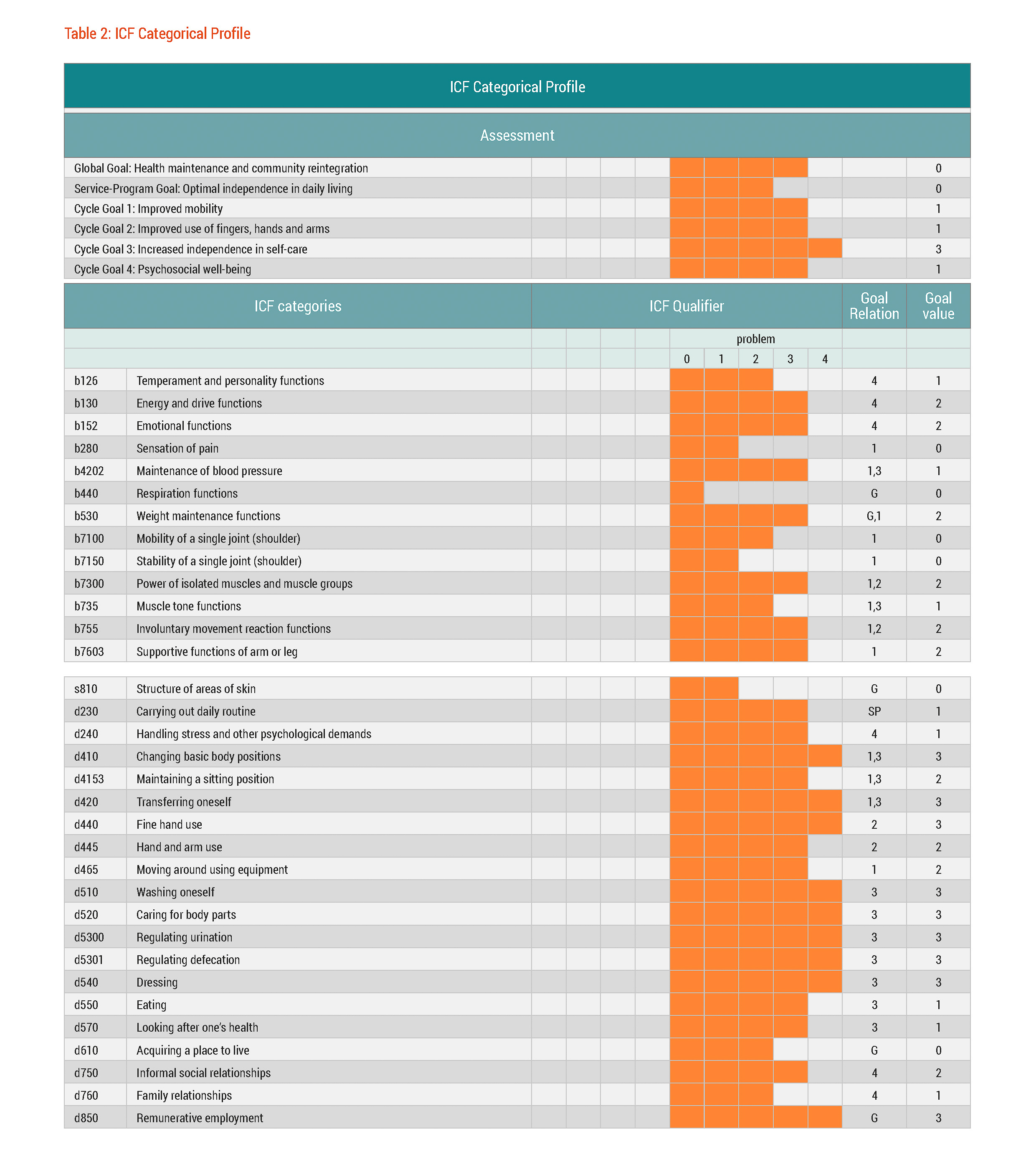Goal-setting/Determination of Intervention Targets
The brief version of the ICF Core Set for SCI in the post-acute context is a selection of 25 categories from the whole International Classification of Functioning, Disability and Health (ICF) that are considered the most relevant for describing the functioning of persons with SCI in post-acute settings, such as first rehabilitation.1620{cs15-fn21} These 25 categories were rated using ICF qualifiers to create an ICF Categorical Profile, a visual depiction (bar chart) of the results of the first comprehensive assessment of Ingrid's functioning. See table 2.

Table 2: ICF Categorical Profile; ICF Qualifier: rate the extent of problems (0 = no problem to 4 = complete problem) in the components of body functions (b), body structures (s), activities and participation (d), and the extent of positive (+) or negative impact of environmental (e) and personal factors (pf); Goal relation: 1, 2, 3, 4 refers to Cycle Goal 1, 2, 3, 4; SP refers to the Service-Program Goal; G refers to the Global Goal; Goal value refers to the ICF qualifier to achieve after an intervention. Note: This table only displays an excerpt of the ICF Categorical Profile; only the categories that are associated with a goal and for which a goal value has been identified (i.e. intervention targets) are shown.
Setting Long-term and Short-term Goals
Ingrid's rehabilitation team also used the ICF Categorical Profile to document the long-term and short-term goals that the team set together with Ingrid. As a long-term global goal they defined ‘health maintenance and community reintegration’. To help achieve the global goal, a service-program goal i.e. the goal Ingrid and her rehabilitation team intended to achieve at the end of the Rehab-Cycle®, was defined as ‘optimal independence in daily living’. They also set four short-term cycle goals, each contributing toward reaching the service-program goal:
- Cycle goal 1: Improved mobility
- Cycle goal 2: Improved use of fingers, hands and arms
- Cycle goal 3: Increased independence in self-care
- Cycle goal 4: Psychosocial well-being
Cycle goal 4 ‘psychosocial well-being’, a major theme in Ingrid's Rehab-Cycle® and the focus of this case study, included emotional stability and optimal coping.
In defining these long-term and short-term goals, the rehabilitation team also considered Ingrid's personal aims.
The base-line status of all of the goals were also rated using ICF qualifiers. At the time of the assessment, all of Ingrid's cycle goals, except for cycle goal 3 ‘increased independence in self-care’, were rated with an ICF qualifier of 3 i.e. severe problem. Self-care posed a complete problem for Ingrid; thus cycle goal 3 was rated with an ICF qualifier of 4.
Determining Intervention Targets
ICF qualifiers were also used to define goal values for the ICF categories that corresponded to the long-term and short-term goals set; these categories are called intervention targets. The goal values defined were what Ingrid and her rehabilitation team had intended to achieve after the intervention phase of the Rehab-Cycle®. The intervention targets that corresponded to cycle goal 4 ‘psychosocial well-being’ included:
- b126 Temperament and personality functions (e.g. optimism)
- b130 Energy and drive functions (e.g. energy level)
- b152 Emotional functions (e.g. range of emotions)
- d240 Handling stress and other psychological demands
- d750 Informal social relationships
- d760 Family relationships
- e310 (Support of) immediate family
- e410 Individual attitudes of immediate family members
The following personal factors were also defined as intervention targets, since they were seen as essential to the success of cycle goal 4:
- Acceptance of health and life situation
- Knowledge of SCI
- Relating to her own body
- Coping strategies
For the intervention targets that corresponded to all the cycle goals, see table 2.
In the intervention phase of the Rehab-Cycle® each intervention target was assigned to one or more members of the rehabilitation team, who conducted appropriate interventions.